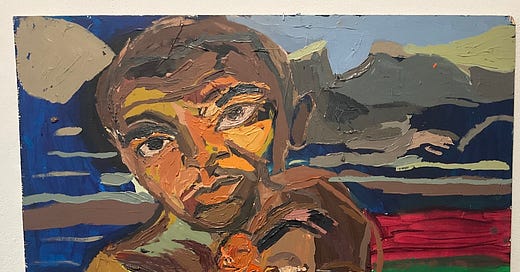This week, I saw four exhibitions at small galleries in the Lower East Side. It might be projection on my part, but they seemed to speak to the difficulties of adulthood. They focus on how tiring and confusing things can be. Some reminisce about the simplicity of childhood or cavemen times, as if to exclaim, “Life does not have to be this way!” But, I’m not sure they convincingly prove that life was any easier back then.
Clintel Steed - Mysteries from Past Moons at the Equity Gallery through May 4, 2024
Clintel Steed’s paintings in Mysteries from Past Moons at the Equity Gallery deal with the difficulty of getting older—specifically, the process of negotiating the growing divide between your dreams and reality. The show is framed around two portraits of a couple at different stages in their lives. The first shows them young, sitting in the morning sun with tighter skin, light smiles, and relaxed postures. The second shows them at night with bags under their eyes and more regimented postures like in a Renaissance donor portrait. There is one painting of a father holding his infant in his arms—his head enlarged as if he’s a baby himself, expressing a kinship with his child. The nod towards the stultification of adulthood is clear enough, but Steed opens a crack to something deeper and more complex: his buried desires and anxieties. The rest of the paintings portray abstracted battles and violence, held together only by the fact they all appear to have emerged from the artist’s unconscious. They’re messy— the canvases sag because they were stretched imperfectly, there are drips of paint scattered on the surface, and he hacks paint onto the surface. The viewer is asked to be a psychotherapist as we try to help Steed make sense of his confusion and disparate dreams.
Arthur Simms - Icema’s World at Martos Gallery through June 15, 2024
In a tribute to his mother, Icema Erica Simms, Arthur Simms’ exhibition Icema’s World at Martos Gallery displays sculptures assembled out of objects he could have found in her attic or between the couch cushions in her living room. He amasses buttons, strands of hair, keys, childhood drawings, and materials for arts and crafts onto canvas like Rauchenbergian combines. There’s a couple piles of rocks and meticulously arranged rows of feathers—the sorts of things kids notice on walks in the park and bring home as treasures. One canvas displays hoarded letters, receipts, and notices that build up in a mother’s drawer and probably should have been thrown away decades ago. The exhibition is intertwined with a related but decidedly distinct showing of paintings by Simms’ wife, Lucy Fradkin. She offers a series of folk art-style paintings of couples in homey living rooms surrounded by collaged pictures of quaint domestic objects like a silver tea kettle and a flower pot. Together, the gallery feels like an abstracted weekend visit home, invoking that funny feeling of being in your mother’s house—at once calmed by the return to the carefree mind of a child and bothered by the inescapability of her hokey habits.
Whose Muse at Palo Gallery through June 1, 2024
Whose Muse at Palo Gallery is a collection of photos and paintings of faces. The only thing they have in common is that they’re all a little sad. The exhibition text postures the works as engaging with the shallowness of our fast-paced digital image culture. But there are too many works of art (most have just six inches between them, or at most a foot and a half for the bigger ones), and they are too disparate in style (some are psychedelic, some are realist, some are pointilist) to see them as a coherent whole. Still, there are many excellent pieces if seen in isolation, and those few can muster a formidable take about the exhibition's supposed theme. There are a couple paintings by the young artist Asher Liftin done in a stylistic mix of Roy Liechtenstein and Georges Seurat. He catches his subjects at off-moments as if he decided to take their photos at random and paint them later. One of his paintings shows a friend reading on his phone, the other is of the famous art critic Robert Storr uncomfortably sitting in a car. Then there’s a drawing by the master Lucian Freud of his doctor glancing downward with his brow’s furrowed folds twisting together in the shape of a tornado. Finally, I was caught in awe by a painting on paper by Miriam Beerman—a dumb stub of a head that hogs the whole composition with ghostly and inexpressive features. These few works create a conversation about the numbing effect of staring at a screen all day, and the way it can simultaneously make you feel dead inside but also lead you to ponder the meaning of life.
Farrell Brickhouse - Looking Back at Tomorrow at JJ Murphy Gallery through May 18, 2024
Farrell Brickhouse’s paintings read like cave drawings with their rough and chiseled surfaces and their simplistic and primitive subjects. Many are of people holding animals or plants—a dog, a fish, a collection of flowers. Brickhouse reduces human life to the simplest of relations: man and nature. He paints them by smacking sludge-like paint onto the canvas and mixing colors like concrete. Some of the paintings were literally made of scraps of semi-dried paint discarded by his students at the School of Visual Arts in New York. A few paintings veer into the mystical and dreamy, like one of a man suspended in free fall with glitter mixed into the paint. Despite the basic and essential mark-making, the brush strokes and figures are not particularly expressive. The subjects’ faces are deadening. The paintings are childish and sloppy and there’s almost no emotion to be found—just the bare essentials of life.







